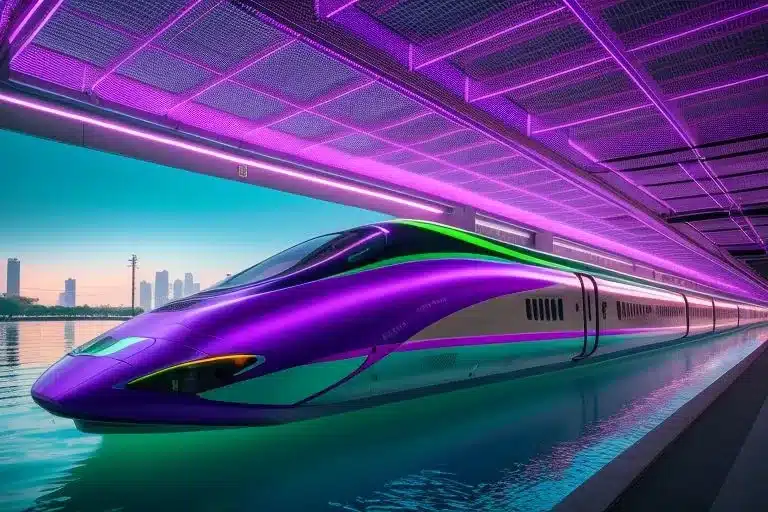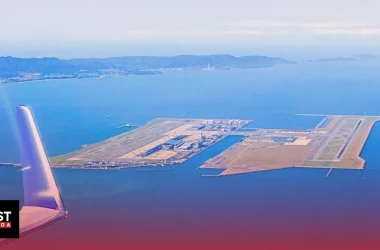China, a world leader in high-speed rail, has once again pushed the boundaries of modern engineering. In a remarkable achievement, China has unveiled its first overwater bullet train, a feat unparalleled anywhere else in the world. Combining speed, elegance, and breathtaking views, this technological marvel is set to redefine the future of transportation.
What’s even more impressive is that it was constructed using AI powered robotics and environmentally friendly steel. It’s also fully automated!
But this $7.4 billion project wasn’t made without controversy.
The new railway line has a stop just 10 kilometers away from Taiwan, signaling the project’s profound geopolitical significance by connecting the Fujian province to the independent island of Taiwan.
A new innovation in the high-speed rail industry
China has been a global leader in the high-speed rail industry since the mid-2000s. As of last year, China has the world’s longest and most extensive high-speed rail network, totaling 42,000 kilometers. To put that in perspective, its high speed rail network is 3 times the length of North and South America combined!
And now, it’s added another massive project to its portfolio.
This year on the 28th of September, China achieved a great modern engineering feat when it launched its first overwater bullet train. Not only is it one of the fastest trains in the world, operating at a maximum speed of 350 km/h, but it is also the first overwater bullet train in the world!
This impressive project was designed by the China Railway Siyuan Survey and Design Group Co Ltd. and travels on a 277-kilometer rail line along the Fujian province’s southeastern coasts.
This means the new bullet train connects the key cities of Zhangzhou, Xiamen, and Fuzhou which are important economic hubs. Fuzhou is the province’s capital and also an important industrial and transportation hub. Xiamen is a port city, located across the strait from Taiwan. And although Zhangzhou may be less notable compared to the other two cities, a major petrochemical plant owned by Taiwan-based Xianglu Group is located there.
So you can see how having a bullet train connecting these cities would come in handy. But besides that the train also offers passengers a beautiful view of the sea with 20 kilometers of train track actually passing over the water. Because of this, 85% of the railway line is made up of 84 bridges and 29 tunnels.
China’s new technology
Construction on this project was very difficult. Because of the track’s location on the water, they had to deal with strong winds, high waves and deep waters. When construction for the megaproject began in 2017, workers grappled with these issues before switching to robots powered by artificial intelligence just a year later.
These robots kept construction workers out of extremely dangerous situations, laying 1.5 kilometers of train track per day before they were upgraded in 2021 to 2 kilometers.
While the robots were very necessary for this project, their use also symbolizes China’s shift to automated manufacturing. The issue for China is clearly not a lack of workers since it has already accomplished incredible infrastructure projects with its workforce. But the lockdowns caused by its Zero-Covid policies shut down work on a lot of projects. Not to mention, the rapid increase in labor costs have also put a wrench in China’s ambitious infrastructure plans.
From 2019 to 2020 labor costs jumped from $5.78 to $6.50 which is why Chinese officials are relying more heavily on a robot workforce to keep up with production demand. This combined with its birth rate dropping to a record low of 1.09 in 2022 – the lowest of any country with a population over 100 million – might necessitate the use of robots in the future.
There are other benefits to using a robot workforce as well. Automated technology can collect real-time data from the construction site and transmit it to warehouses – streamlining the process for supplying materials and components.
It looks like China sees automated construction as its future. Their factories already use robots for almost every step of the assembly process, so the next step is to eliminate the need for construction workers in their infrastructure projects as well.
But besides AI powered robots, there are some other very interesting details about this project. For one thing, the Chinese government used corrosion-resistant steel which has added to its surface. This protects the steel against moisture, preventing rusting.
Aside from being durable and long-lasting, stainless steel is also good for the environment because it is non-toxic, easy to recycle and requires less energy to produce than other materials.
But aside from the construction process itself, there is a lot that makes this overwater bullet train interesting.
The project was first announced in 2015 as an addition to the Fuzhou-Xiamen high-speed line which was already operating at over 100% occupancy. Because of the Fujian region’s mountainous terrain, the transportation system had become strained and the new addition would help alleviate it.
Controversial plans for the project
However, the real reason for this project was much more than just improving connectivity in the region. Fujian is significant for another thing – its proximity to Taiwan.
In fact, Fujian is the closest part of China to the independent island of Taiwan. For perspective Xiamen, one of the cities this train line connects, is just 10 kilometers away from Kinmen, a western region in Taiwan.
The project’s proximity to Taiwan is hard to ignore and it comes at a time when China is also urging cross-strait exchange between Fujian and Taiwan.
China has already announced its plans to turn the Fujian province into a zone for integrated development with Taiwan. So it’s clear that China built the railway with that goal in mind.
Government officials stated that the bullet train would make travel easier and enhance investment opportunities between mainland China and Taiwan, adding that it could build a high-speed railway line directly connecting Fujian and Taiwan by 2035.
China seems very serious about its intentions here and the Communist Party of China’s Central Committee and the State Council have even encouraged Taiwanese companies based in Fujian or near it to list themselves on the Beijing stock exchange. Besides this, Taiwanese visitors have also been encouraged to settle down in the province and fully integrate themselves into the mainland.
The government’s statement and overt efforts at assimilation were extremely controversial since China refuses to acknowledge Taiwan as an independent country.
Before starting its overwater bullet train, China had actually proposed plans for an underwater tunnel beneath the Taiwan Strait linking it with China’s railway network. Taiwan’s Mainland Affairs Council, which is responsible for dealing with China’s policies, stated that such projects should be unilaterally decided and that even China’s overseas Belt and Road Initiative projects needed to be discussed with host countries.
It seems that China was hoping to flex its power and try to establish Taiwan’s place as part of China by connecting the two countries via railway, without Taiwan’s permission. Obviously, Taiwan refused the underwater tunnel which led Beijing to the next best thing – an overwater bullet train stopping just 10 kilometers from Taiwan.
However, Taiwanese defense officials have noted that the Taiwan Strait is a natural barrier between mainland China and Taiwan, and stated that Taiwan will continue to defend its national sovereignty and integrity of its territorial waters, lands, and airspace. Making it clear that the Taiwanese government only views these plans as the CCP’s wishful thinking.
Political tensions aside, any railway project connecting mainland China and Taiwan would face extreme technical difficulties, including drilling through complex layers of granite rocks and building around two earthquake fault lines in the Taiwan Strait. A Chinese government scientist even said that if this link happens, it will be the largest and most challenging civil engineering project of the 21st century.
China’s motivations
So far Taiwan’s reaction to the high-speed railway line has been almost exactly the same as its reaction to the underwater tunnel. The council has also pointed to China’s domestic economic problems, countering Beijing’s claims that linking Fujian and Taiwan would improve its economy since mainland China can’t even improve its current economic situation.
On this note, it’s also possible that part of China’s motivation for linking Taiwan with mainland China is the opportunity to capitalize on the growing Taiwanese economy fueled by Taiwan’s dominance in the semiconductors industry. Taiwan makes up to 60% of the world’s most advanced semiconductors, a market that China is eager to create its own supply chain for, especially after the trade war with the U.S. that limited China’s exposure to new American chip technology. As a result, foreign investments in China’s semiconductor industry dropped from 48% in 2018 to just 1% in 2022.
Benefits to Fujian
Setting all the geopolitical intrigue aside, China’s overwater bullet train is still a huge benefit to locals in Fujian. And since there is some overlap with Taiwanese companies working in the region, it may benefit them too.
For example, the fastest trip between Fuzhou and Xiamen used to take around 1 hour and 20 minutes. Now, the new bullet train reduced the time needed for this trip to just under an hour. It also boosted the economic and cultural exchanges between the cities it linked, potentially increasing tourism in the province as well.
Whether this impressive megaproject is just another example of China’s desire to integrate with Taiwan or not does not take away from the engineering marvel China has created. Its impressive construction using AI powered robots and coverage of 20 kilometers of sea, highlights China’s ability to make the seemingly impossible, possible.
Disclaimer
Please visit and read our disclaimer here.









